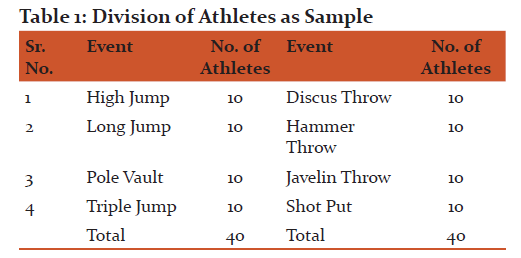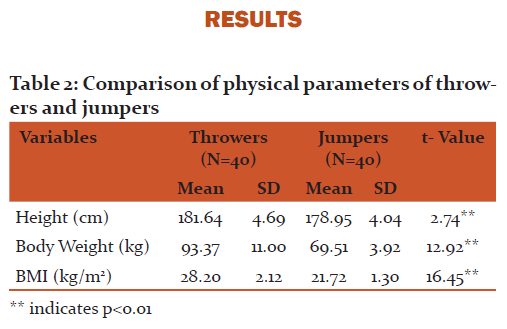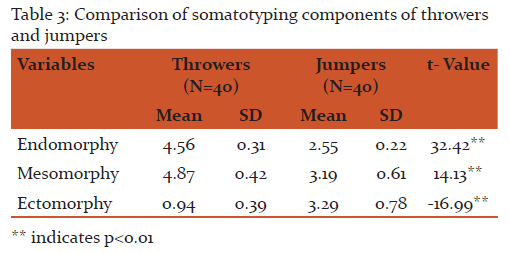IJCRR - 9(4), February, 2017
Pages: 38-40
Date of Publication: 20-Feb-2017
Print Article
Download XML Download PDF
Comparison of Physical Parameters and Somatotyping Components of the Throwers and Jumpers
Author: Karanjit Singh
Category: Healthcare
Abstract:Aim: The purpose of the present study was to evaluate and compare the physical parameters and somatotyping components of throwers and jumpers.
Methodology: 80 (40 throwers and 40 jumpers) male university level athletes were assessed during the All India Inter University Athletic Meet. The age of athletes was between 18 to 25 years. All subjects were assessed for height, weight, breadths and circumferences.
Results: The independent samples t-test revealed that the throwers were significantly taller (p< 0.01) and heavier (p< 0.01) than the jumpers. The throwers were also reported to have significantly greater body mass index (p< 0.01), endomorphy (p< 0.01) and mesomorphy (p< 0.01) in comparison to jumpers. The jumpers had significantly greater ectomorphy component (p< 0.01) than the throwers.
Conclusion: It is concluded that in most of the parameters there were significant differences between throwers and jumpers.
Keywords: Somatotyping, Body Mass Index, Throwers, Jumpers, Endomorphy, Mesomorphy
Full Text:
INTRODUCTION
The physical trainers and coaches have understood the importance of various factors such as training, skill, personality, motivation in the sports performance but most important of them all is physical parameters and somatotyping characteristics because these factors are definite predictions of the degree of efficiency and level of success of sportsperson. The sports performance of athletes is greatly influenced by such factors as age, height, weight and body structure. It is also observed that persons of the same age group vary in body size and shape, the individuals of the same height differ greatly in body weight, the persons may weigh the same, but the relative proportion of muscle, fat, and bone will be varied (Johnson and Nelson 1982). The human physique differs in many ways and variation in physical characteristics is an interesting aspect. This variety of human physique plays an important role to attain better performance in particular sports. Every game requires a specific type of body where as unsuitable body types in relation to the sports may build great stumbling block in the progress of the sports performance. According to Heath and Carter (1967) somototype is a description of the present morphological conformation. It is expressed in a numeral rating consisting of three sequential numerals always recorded in the same manner. Each numeral represents the evaluation of the three primary components of physique which describe individual variations in human morphology and composition. Physique refers to the shape, the size and type of an individual. All three factors are closely interrelated with each other and are manifestations of the internal structure and tissue components which are affected by the environmental and genetic factors (Sodhi and Sidhu, 1984)
One of the useful indirect techniques of evaluating physique characteristics is somatotyping. It is an established fact that the ideal body types of athletes varies according to the requirements of sport or event. The combined rating of each component describes an individual’s somatotype. If one component is dominant then the somatotyping describes that component (Carter & Heath, 1990; Duquet et al., 1996). Specific athletic events require different body types and weights for maximal performance (American Dietics Association, 1987).
Somatotype analysis can provide a synthetic descriptive picture of the kinanthropometric characteristics of high level athlete. In this sense, the somatotyping method is believed to yield better results than simple linear anthropometric measurements (Rienzi et al., 1999), since it combines adiposity, musculo-skeletal robustness and linearity. The technique of somatotyping as a means of assessing body shape and composition independent of size has been applied to the description of groups of outstanding athletes. The present study aims to evaluate and compare the physical parameters and somatyping components of the university level throwers and jumpers.
METHODOLOGY
The present was conducted on 80 university level jumpers and throwers which were purposively selected from All India Inter University Athletic Meet held at Manonmaniam Sundaranar University Tirunelveli (Tamilnadu). The study was conducted jumpers and throwers of age between 18 to 25 years. The study was conducted only on male jumpers and throwers. The high jumpers, long jumpers, triple jumpers and pole vaulters were selected as subjects. The throwers viz. discus throwers, javelin throwers, hammer throwers and shot putters were selected as subjects for the study.

Data Collection
Body weight was measured with portable weighing machine to the nearest 0.5 kg. Height was measured by using the standard anthropometric rod (HG-72, Nexgen ergonomics, Canada) to the nearest 0.5 cm. Widths and diameters of body parts were measured by using sliding caliper. Circumferences of the body parts of the throwers were measured with the help of steel tape to the nearest 0.5 cm. Body mass index (BMI) was calculated by the following formulae:
BMI (Kg/m2) = (Body mass in kg)/ (Stature in m2) (Meltzer et al., 1988)
Somatotyping
Somatotype components (endomorphy, mesomorphy, ectomorphy) were estimated according to protocol of Carter and Heath (1990) using the next equations
Endomorphy = - 0.7182 + 0.1451 (X) - 0.00068 (X2) + 0.0000014 (X3)
where X = (sum of triceps, subscapular and supra-iliac skinfolds) multiplied by (170.18/height in cm).
Mesomorphy = 0.858 ´ humerus breadth + 0.601 ´ femur breadth + 0.188 ´ corrected arm girth + 0.161 ´ corrected calf girth – height 0.131 + 4.5.
Where corrected arm girth =flexed arm girth - triceps skinfold/10
corrected calf girth = maximal calf girth - calf skinfold/10.
Ectomorphy = 0.732 HWR - 28.58
Where HWR = height / cube root of weight
If HWR is less than 40.75 but greater than 38.25 then
Ectomorphy = 0.463 HWR - 17.63
If HWR is equal to or less than 38.25 then
Ectomorphy = 0.1
Statistical analysis
Values were presented as descriptive statistics viz. mean values and SD. Independent samples t tests was used to compare the throwers and jumpers. Data was analyzed using SPSS Version 16.0 (Statistical Package for the Social Sciences, version 16.0, SSPS Inc, Chicago, IL, USA). Significance levels were set at p<0.05.

Comparison of physical parameters between throwers and jumpers is presented in table-2. The throwers were significantly taller (t=2.74, p=0.007) and heavier (t=12.92, p<0.0001) than those of the jumpers. Similarly, throwers were also found to have significantly greater BMI (t=16.45, p<0.0001) when compared to jumpers.

Table 3 presents the comparison of somatotyping components between throwers and jumpers. The throwers had significantly higher endomorphic (t=32.42, p<0.0001) and mesomorphic (t=14.13, p<0.0001) components when compared to the jumpers. However, ectomorphic component in throwers was significantly lower (t=16.99, p<0.0001) when compared to jumpers.
DISCUSSION
The results of the present study show that the throwers and jumpers differed physical parameters and somatotyping components. When throwers and jumpers were compared it was found that throwers were taller and heavier. Furthermore, the throwers showed greater endomorphic and mesomorphic components. On the other hand jumpers had greater ectomorphic component as compared to throwers. The above reported results are supported by other studies on throwers and jumpers (Tanner, 1964; Malhotra et al., 1972; Thorland et al., 1981; Mokha and Sidhu, 1988; De et al., 1991). The studies on the athletes of different level of performance with regard to their physical parameters and body structure help in the understanding of the morphological, biomechanical and physiological demands of modern training methods and the optimal requirements for successful participation as well as selection and identification of talented young athletes (Kruger, 2004). Therefore, the results of this study could help in identifying young talented athletes and also guide in training methods to help them attain the required body composition for maximum performance.
CONCLUSION
In conclusion, it was found that the significant differences were existed among throwers and jumpers in physical characteristics and somatotyping. The throwers were taller and heavier than the Jumpers. The throwers were also reported higher endomorphy, mesomorphy and BMI in comparison to the low performer throwers. On the other hand, jumpers had higher ectomorphy component.
ACKNOWLEDGEMENT
Author acknowledges the immense help received from the scholars whose articles are cited and included in references of this manuscript. The author is also grateful to authors/editors/publishers of all those articles, journals and books from where the literature for this article has been reviewed and discussed.
References:
- American Dietetics Association (1987) Position of the American Dietetics Association Nutrition for the physical fitness and athletic performance for adults. J. Am. Diet Assoc., 76:437-443.
- Carter, J.E.L. and Heath, H.B. (1990) Somatotyping—Development and Application. Cambridge University Press.
- De, A.K., Ray, A.S., and Debnath, P.K. (1991) Simple anthropometry and peak expiratory flow rate in elite South Asian athletes. Journal of Sports Medicine and Physical Fitness, 31:598.
- Duquet, W. and Carter, J.E.L. Eston, R. and Reilly, T. (eds) (1996) Somatotyping. Kinanthropometry and exercise physiology laboratory manual pp. 41-43. E & FN Spon , London.
- Heath, B.H. and Carter, J.E.L. (1967) A modified somatotype method. American Journal of Physical Anthropology, 27:57-74.
- Johnson, B.L. and Nelson, J.K. (1982) Practical Measurements for Evaluation in Physical Education. Burgess Publishing U.S.A (in India, Surjit Publicaiton, Delhi).
- Kruger, Ankebe (2004) Kinantropometriese en asimmetriese profile van internasionale manlike elite-spiesgooiers. M.Sc. thesis, north-west university, Potchefstroom Campus.
- Malhotra, M.S., Joseph, N.T., Mathur, D.N. and Gupta, J. (1973) physiological assessment of Indian hockey players, Sports Medicine, 2:5.
- Meltzer, A., Mueller, W., Annegers, J., Grimes, B. and Albright, D. (1988). Weight history and hypertension. J. Clin. Epidemiol., 41:867–874.
- Mokha, R. and Sidhu, L.S. (1988) Fat and fat patterning of Indian female athletes at different levels of competition, Annalei dell isef VII : 49 – 50.
- Rienzi, E., Reilly, T., Malkin, C. (1999) Investigation of anthropometric and work-rate profiles of Rugby Sevens players. J. Sports Medicine and Physical Fitness. 39: (2), 160-164.
- Sodhi, H.S. and Sidhu, L.S. (1984) Physique and Selection of Sportsmen. Punjab Publishing House, Patiala.
- Tanner, J.M. (1964). The Physique of the Olympic Athletes (Allen & Unwin London), 1964.
- Thorland, W.G., Johanson, G.O., Fargot, T.G., Tharp, G.D. and Hammer R.W. (1981) Body composition and somatotype characteristics of junior Olympic athletes. Medicine and Science in Sports and Exercise, 13 (5): 332-338.
|






 This work is licensed under a Creative Commons Attribution-NonCommercial 4.0 International License
This work is licensed under a Creative Commons Attribution-NonCommercial 4.0 International License